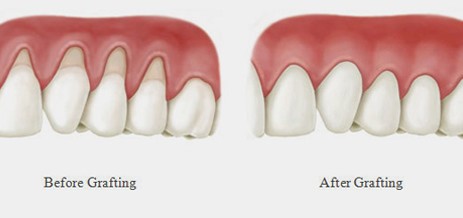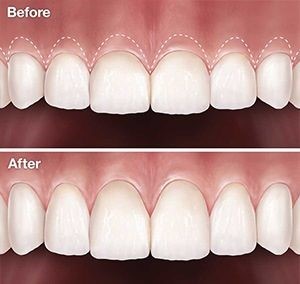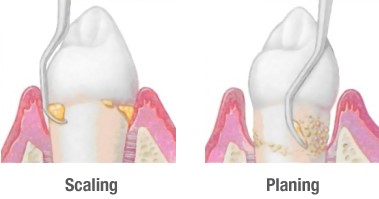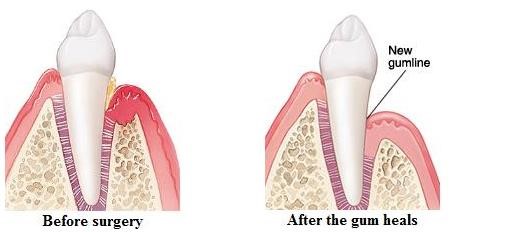WHAT IS A PERIODONTIST?
A periodontist is a dentist who specializes in the prevention, diagnosis and treatment of periodontal disease and in the placement of dental implants. A periodontist typically has had two to three years of additional training in diagnosing and treating gum disease and its associated problems. Periodontists are familiar with the latest techniques for diagnosing and treating periodontal disease. Moreover, periodontists can perform cosmetic periodontal procedures to improve your smile. Often, dentists refer their patients to a periodontist when their periodontal disease is advanced.

ABOUT COSMETIC SURGERY
There are a number of procedures we can perform to improve the aesthetics of your face and smile. These include:
Soft tissue gum grafting
Gum recession is a result of gum tissue and bone loss leading to exposed tooth roots. We will use gum tissue from the roof of your mouth or another donor source. Soft tissue grafting surgery will repair the defect and will also help to prevent additional gum recession and bone loss. Further benefits will be reduction of tooth sensitivity, improvement of aesthetics and function and a more stable periodontal health.

Crown lengthening
In some cases, periodontal procedures help lay the groundwork for restorative and cosmetic dentistry and/or improve the esthetics of your gum line. If you have a “gummy” smile because your teeth appear short, it is possible that your teeth may be the right length, but are covered by excessive gum tissue. Aesthetic crown lengthening corrects this condition.This can be done to one tooth, to even your gum line, or to several teeth to expose a natural, broad smile.
Functional crown lengthening often makes a restorative or cosmetic dental procedure possible. This is especially true if you have a tooth that is decayed, broken below the gum line, or has insufficient tooth structure for a restoration, such as a crown or bridge. Crown lengthening adjusts the gum and bone level to expose more of the tooth so it can be restored.
Gummy smile or uneven gum line
If your teeth look too short and your smile is too gummy or your gums cover too much of some teeth while leaving the others the right length, crown lengthening might be the solution. During this procedure, excess gum tissue is removed to expose more of the crown of the tooth. Your gum line is then sculpted.

Frenectomy
A labial frenulum is a thin band of soft tissue that connects from the lips or cheeks to the outer gum tissue. A lingual frenulum connects the tongue to the floor of the mouth. When these bands are too short one can experience being “tongue tied” or “lip tied”. These short lingual frenula can be the cause of speech impairment and in children can also lead to developmental abnormalities. A short labial frenulum can also be the cause of gum recession on teeth.
A frenectomy can help to facilitate growth development in children, prevention of gum recession and can also facilitate orthodontic therapy in certain situations.
ABOUT PERIODONTAL DISEASE
Bacterial plaque is the primary cause of periodontal disease. However, other factors can contribute to gum disease. These include:
- A family history of dental disease
- Behavioral factors such as smoking, which impedes health and repair of gum tissue, and poor oral hygiene
- Poor nutrition
- Hormonal changes from pregnancy, puberty, menopause, and monthly menstruation. These changes can make gums more sensitive, thereby making it easier for gingivitis to develop
- Illnesses such as cancer or HIV that interfere with the immune system. Diabetes also affects the body’s ability to use blood sugar, and thus, diabetics are at higher risk of developing periodontal disease
- Some drugs (such as diphenylhydantoin, also called Dilantin, the anti-angina drug nifedipine, also called Procardia or Adalat), can cause abnormal growth of gum tissue, as well as calcium channel blockers, which are used to control high blood pressure or for people with heart problems; cyclosporine, a medication that suppresses the immune system and is used to keep the body from rejecting transplanted organs, and oral contraceptives
- Some medications, which lessen the flow of saliva, which has a protective effect on teeth and gums
- Stress
- Clenching or grinding your teeth
Treatment
Scaling and Root Planing
Cases of periodontal (gum) disease that do not respond to more conventional treatment and self-care such as brushing and flossing may require a special kind of cleaning called scaling and root planing.
The procedure begins with administration of a local anesthetic to reduce any discomfort. Then, a small instrument called a “scaler,” or an ultrasonic cleaner, is used to clean beneath your gum line to remove plaque and tartar.
The root surfaces on the tooth are then planed and smoothed. This allows the gum tissue heal and reattach itself to the tooth in less advanced cases of disease.

Pocket reduction/ Osseous Surgery
Your bone and gum tissue should fit snugly around your teeth like a turtleneck. When you have periodontal disease, this supporting tissue and bone is destroyed, forming “pockets” around the teeth. Over time, these pockets become deeper, providing a larger space for bacteria to thrive.
As bacteria accumulate and advance under the gum tissue in these deep pockets, additional bone and tissue loss follow. Eventually, if too much bone is lost, the teeth will need to be extracted.
Flap surgery is can be performed to remove tartar deposits in deep pockets or to reduce the periodontal pocket and make it easier for you or your dental professional to keep the area clean. This common surgery involves lifting back the gums and removing the tartar. The gums are then sutured back in place so that the tissue fits snugly around the tooth again.
A pocket reduction procedure is recommended if daily at-home oral hygiene and Scaling and Root Planing cannot effectively reach these deep pockets.
In some cases, irregular surfaces of the damaged bone are smoothed to limit areas where disease-causing bacteria can hide (“Osseous (meaning ‘bone’) surgery”). This also allows the gum tissue to better reattach to healthy bone.

Regeneration
Periodontal disease causes the supporting tissue and bone around and below your teeth to become lost. Regenerative procedures can reverse some of the damage by regenerating lost bone and tissue.
The procedure involves folding back the gum tissue and removes the disease-causing bacteria. Membranes (filters), bone grafts and/ or tissue- stimulating proteins can be used to encourage your body’s natural ability to regenerate bone and tissue.
